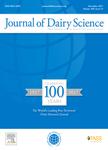版权所有:内蒙古大学图书馆 技术提供:维普资讯• 智图
内蒙古自治区呼和浩特市赛罕区大学西街235号 邮编: 010021

作者机构:Univ Delaware Dept Anim & Food Sci Newark DE 19716 USA
出 版 物:《JOURNAL OF DAIRY SCIENCE》 (乳品科学杂志)
年 卷 期:2008年第91卷第1期
页 面:236-240页
核心收录:
学科分类:0832[工学-食品科学与工程(可授工学、农学学位)] 0905[农学-畜牧学] 08[工学]
摘 要:The objective of this study was to determine if exposure to high temperatures in water affects the viability of various silage inoculants. Inoculants were enumerated on De Man, Rogosa, Sharpe agar to standardize a final count (colony-forming units) in water such that about 500 mL added to 1 tonne of wet forage would achieve a recommended application rate of about 100,000 cfu of lactic acid bacteria (LAB) per gram of wet forage. Testing was done in 4 sequences (SEQ). For each SEQ, inoculants were mixed in deionized water for 45 min at 30 degrees C followed by incubation for 6 h at 30 degrees C (SEQ 1), 35 degrees C (SEQ 2), 40 degrees C (SEQ 3), or 45 degrees C (SEQ 4) in duplicate 125-mL flasks rotating at 125 rpm. After 6 h, rotation was stopped and the temperature was lowered to 30 degrees C for the next 18 h for all SEQ. Numbers of LAB were enumerated at 0, 3, 6, and 24 h. Each sequence was repeated twice. Incubation at a moderate temperature (SEQ 1) did not affect the viability of the microbial inoculants. The viability of the inoculants declined with increasing temperature (SEQ 2 to 4) but the effect varied by inoculant. For some inoculants exposure to 35 degrees C resulted in substantial decreases in viable cells (loss of 0.5 to 1 log cfu/ mL). Incubation at higher temperatures resulted in even greater losses in viability for some inoculants. Losses of more than 0.5 log cfu/mL would most likely make the application of these inoculants ineffective in the field. Lactobacillus plantarum MTD/1 was the most thermotolerant organism tested, because it was unaffected by all temperatures (30 to 45 degrees C) after 3 h of incubation. Lactobacillus plantarum MTD/1 and Lactobacillus buchneri 40788 also appeared to have better thermotolerance as their numbers substantially increased between 6 and 24 h in SEQ 4. These data show that some silage inoculants are more thermotolerant than others and that precautions should be taken to ensure that microbial inoculants that are ap